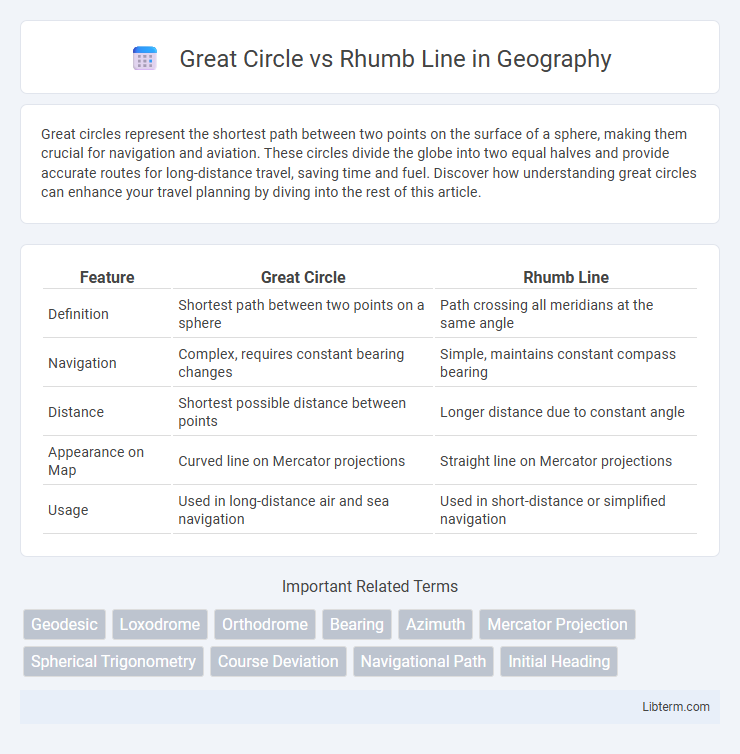Great circles represent the shortest path between two points on the surface of a sphere, making them crucial for navigation and aviation. These circles divide the globe into two equal halves and provide accurate routes for long-distance travel, saving time and fuel. Discover how understanding great circles can enhance your travel planning by diving into the rest of this article.
Table of Comparison
| Feature | Great Circle | Rhumb Line |
|---|---|---|
| Definition | Shortest path between two points on a sphere | Path crossing all meridians at the same angle |
| Navigation | Complex, requires constant bearing changes | Simple, maintains constant compass bearing |
| Distance | Shortest possible distance between points | Longer distance due to constant angle |
| Appearance on Map | Curved line on Mercator projections | Straight line on Mercator projections |
| Usage | Used in long-distance air and sea navigation | Used in short-distance or simplified navigation |
Introduction to Great Circles and Rhumb Lines
Great Circles represent the shortest path between two points on a sphere, making them essential in global navigation and aviation for optimizing distance and fuel efficiency. Rhumb Lines, also known as loxodromes, maintain a constant compass bearing, simplifying navigation by following straight lines on a Mercator projection map despite being longer than Great Circle routes. Understanding the distinctions between Great Circles and Rhumb Lines is crucial for accurate route planning and effective maritime or aerial travel.
Definition of Great Circle Route
The Great Circle route is the shortest path between two points on the surface of a sphere, defined by the intersection of the sphere with a plane that passes through the center of the sphere. It represents the most efficient navigation path used in aviation and maritime travel to minimize distance and fuel consumption. Unlike Rhumb Line navigation, which maintains a constant compass bearing, the Great Circle route requires continuous adjustment of direction to follow the curvature of the Earth.
What is a Rhumb Line?
A rhumb line, also known as a loxodrome, is a path on the Earth's surface that crosses all meridians at a constant angle, maintaining a steady compass direction. It appears as a straight line on a Mercator projection map, making it valuable for maritime navigation despite being longer than a great circle route. Unlike great circle paths that represent the shortest distance between two points, rhumb lines simplify navigation by keeping a constant bearing.
Mathematical Principles Behind Each Route
Great Circle routes follow the shortest path between two points on a sphere, calculated using spherical trigonometry and geodesic equations. Rhumb Line paths maintain a constant compass bearing, represented mathematically as loxodromes that cross all meridians at the same angle, resulting in a logarithmic spiral on a Mercator projection. The Great Circle minimizes distance by accounting for Earth's curvature, while Rhumb Lines prioritize navigational simplicity despite longer travel distances.
Navigational Tools and Techniques
Great Circle routes represent the shortest distance between two points on a sphere, essential for long-distance navigation using advanced GPS and inertial navigation systems. Rhumb Lines maintain a constant compass angle, facilitating simpler, more reliable course plotting with traditional marine sextants and magnetic compasses. Modern navigational tools often integrate both Great Circle calculations and Rhumb Line plotting to optimize route efficiency and maintain straightforward heading adjustments.
Efficiency: Distance and Time Comparison
Great Circle routes offer the shortest distance between two points on the globe, significantly reducing travel time and fuel consumption compared to Rhumb Line paths. Rhumb Lines maintain constant compass bearings but often cover longer distances, leading to increased travel duration and higher operational costs. In aviation and maritime navigation, utilizing Great Circle routes enhances efficiency by minimizing both distance and time, especially over long-haul journeys.
Practical Applications in Aviation
Great Circle routes are preferred in aviation for long-distance navigation due to their efficiency, minimizing fuel consumption and flight time by following the shortest path between two points on a sphere. Rhumb Lines, which maintain a constant compass heading, are useful for shorter flights or when navigating through airspaces with complex restrictions, simplifying pilot control and instrumentation use. Airlines and pilots balance these methods, often using Great Circle paths for transoceanic flights and Rhumb Lines when precise directional stability is essential.
Practical Applications in Maritime Navigation
Great Circle routes minimize distance and fuel consumption, making them essential for long-haul maritime navigation, especially across oceans. Rhumb Line paths maintain a constant compass bearing, simplifying navigation near coastlines and in regions with complex navigational hazards. Mariners select Great Circles for efficient transoceanic voyages and Rhumb Lines for straightforward chart plotting and maintaining steady courses in coastal navigation.
Advantages and Disadvantages of Each Route
Great Circle routes offer the shortest distance between two points on a sphere, minimizing fuel consumption and travel time, ideal for long-haul flights and maritime navigation. Rhumb Line routes maintain a constant compass bearing, simplifying navigation and making them easier for vessels and aircraft to follow, especially near coastal areas or in regions with complex geography. However, Great Circle paths require continuous course adjustments and advanced navigation systems, while Rhumb Lines often result in longer distances and increased fuel use, which can be inefficient for long-distance travel.
Choosing the Best Route: Factors and Considerations
Choosing the best route between a Great Circle path and a Rhumb Line involves evaluating factors such as distance, navigation ease, and fuel efficiency. Great Circle routes offer the shortest distance between two points on a sphere, reducing travel time and fuel consumption, but require continuous adjustments in bearing. Rhumb Line routes maintain a constant compass heading, simplifying navigation and making them preferable for vessels or aircraft relying on straightforward course monitoring despite being longer in distance.
Great Circle Infographic

 libterm.com
libterm.com